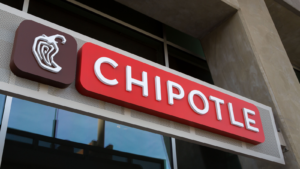
The S&P 500 is the hallmark of portfolio diversification. When most investors aim to “beat the market,” they are talking about this index. It contains 500 profitable publicly traded corporations, with allocations weighted by market cap. For instance, investors will have the most exposure to the largest publicly traded corporation and the least exposure to the 500th largest company on the list.
This index routinely adds and removes stocks based on financial performance and other factors. Furthermore, it’s not easy to get into the S&P 500. A company must fulfill several requirements, such as having a sufficient market cap and reporting a profitable year.
Although many investors use index investing to match the market, it’s possible to outperform the S&P 500. These growth stocks have lived up to the premise and have outpaced the S&P 500 so far. Investors may want to take a closer look at these growth stocks.
Walmart (WMT)

Walmart (NYSE:WMT) is a haven for consumers who want to protect their wallets and buy affordable products. The company can deliver solid earnings during the good times and remain resilient during economic downturns. Walmart has delivered a 30% year-to-date gain, which outpaces the S&P 500’s 18% year-to-date gain.
Walmart also offers a 1.20% yield for its investors. While dividend growth has been an issue in previous years, the company recently announced a 9% dividend hike — the highest dividend increase in more than a decade.
Q1 FY25 financial results suggest that Walmart can continue the rally. Revenue increased by 6.0% year-over-year in that quarter, while adjusted EPS was up by 22.4% year-over-year. Global e-commerce sales were a major highlight, increasing by 21% year-over-year. Store-fulfilled pickups and deliveries continue to pick up momentum. Investors should also monitor the small but growing advertising segment, which reported 24% year-over-year revenue growth.
Amazon (AMZN)

It’s hard to talk about outperforming the S&P 500 without mentioning at least one of the Magnificent Seven stocks. These stocks have carried the index to new heights for several years and heavily influence the Nasdaq Composite.
Amazon (NASDAQ:AMZN) is one of the Magnificent Seven stocks, delivering a 30% year-to-date return. Online marketplace sales continue to grow and achieve double-digit revenue growth in domestic and international markets. That wasn’t the only highlight from Q1 2024 results. While overall revenue increased by 13% year-over-year, the company also reported 17% revenue growth for Amazon Web Services. That part of Amazon’s business generated $25.0 billion in the quarter.
While e-commerce and cloud computing are Amazon’s core specialties, the company is making strides in the advertising market. The tech giant reported $11.8 billion in ad revenue this quarter, a 24% year-over-year increase. Amazon thrives in multiple industries, which should lead to long-term gains for patient investors.
Nu Holdings (NU)

Nu Holdings (NYSE:NU) is a Brazilian digital bank that offers a wide range of financial products and services to the Latin American community. Shares have logged a 65% year-to-date return. It helps that the company recently surpassed 100 million users, most of whom are active.
The digital bank reported an 83% activity rate at the end of the first quarter. This rate demonstrates that 83% of the company’s 100 million customers are active monthly. The bank has more than 83 million monthly active users, and they use multiple financial products. Nu Holdings reported 69% year-over-year revenue growth as customers used the bank’s personal loans, credit cards, bank accounts, brokerage accounts and other resources.
Wall Street analysts still believe that the stock can rise. Seven analysts rate it a Strong Buy, with a projected 5% upside from current levels. The highest price target of $15.20 per share suggests the stock can gain an additional 13%.
Chipotle (CMG)

Chipotle (NYSE:CMG) has been outperforming the stock market for several years. It has almost quadrupled over the past five years and is up 28% year-to-date. The Mexican Grill chain recently completed a 50-for-1 stock split and has been under a correction ever since. This correction presents an opportunity for long-term investors.
The company continues to grow at a robust pace. Revenue increased by 14.1% year-over-year to reach $2.7 billion in the first quarter, and net income rose by 23.2% year-over-year to reach $259.3 million. Chipotle opened 47 new restaurants this quarter and remains on pace to open 285-315 restaurants throughout the year.
Restaurant expansion isn’t the only reason Chipotle’s revenue is still rising. The company reported 7.0% year-over-year growth in comparable restaurant sales. Wall Street analysts are on board and have rated the stock as a Moderate Buy. The average price target suggests a 16% upside, while the highest price target of $80 per share indicates that a 38% gain is possible.
Meta Platforms (META)

Meta Platforms (NASDAQ:META) is another member of the Magnificent Seven that has outperformed the S&P 500 over a lengthy amount of time, including this year. Facebook’s parent company has logged a 44% year-to-date gain and comes with a 0.40% yield. The stock trades at a 29 P/E ratio and trades at a $1.26 trillion valuation.
The social media giant closed out the first quarter with 3.24 billion daily active users, 7% higher than the same time last year. Meta Platforms’ large user base allows it to experiment with new products and AI offerings. As it works on new initiatives, the company performs well with its current business model. Revenue increased by 27% year over year, while net income surged by 117% year over year.
Meta Platforms remain a big hit on Wall Street. The stock is rated a Strong Buy with a projected 6% upside from current levels. The highest price target of $625 per share suggests the company can rally by an additional 25%.
Texas Roadhouse (TXRH)

Texas Roadhouse (NASDAQ:TXRH) isn’t as big as Chipotle, but the steakhouse chain has momentum and a more reasonable valuation. The stock trades at a 34 P/E ratio and offers a 1.44% yield. Shares are up by 42% year-to-date and have more than tripled over the past five years.
The steakhouse chain reported 12.5% year-over-year revenue growth in the first quarter. Net income jumped by 31.9% year-over-year, which should help the company maintain a double-digit dividend growth rate. Texas Roadhouse opened 12 restaurants in the quarter, including three franchises. The steakhouse chain’s comparable sales increased by 8.4% year-over-year at company-owned restaurants. The growth rate came in at 7.7% for franchise restaurants. Both growth rates are respectable and demonstrate that Texas Roadhouse is becoming a fixture in numerous communities.
Wall Street analysts have rated the stock as a Moderate Buy. The average price target only implies a 3% upside, but the highest price target of $191 per share suggests a potential 13% gain.
Crowdstrike (CRWD)

Crowdstrike (NASDAQ:CRWD) has been crushing the stock market. The cybersecurity firm is a recent addition to the S&P 500, delivering a 50% year-to-date gain. Shares are up by more than 400% over the past five years.
The company operates in an industry projected to grow for many years. Cybersecurity is projected to maintain a compounded annual growth rate of 13.8% until 2030. Many companies will benefit from the industry’s success, but few are as well-positioned as Crowdstrike.
While other cybersecurity companies have reported decelerating revenue growth, Crowdstrike continues to charge ahead. The company reported 33% year-over-year revenue growth in the first quarter of fiscal 2025. Crowdstrike operates on a subscription business model and currently has $3.65 billion in annual recurring revenue. Profits are also surging, going from $0.5 million in the same quarter last year to $42.8 million in this quarter.
On this date of publication, Marc Guberti held long positions in AMZN, TXRH, and CRWD. The opinions expressed in this article are those of the writer, subject to the InvestorPlace.com Publishing Guidelines.
On the date of publication, the responsible editor did not have (either directly or indirectly) any positions in the securities mentioned in this article.




